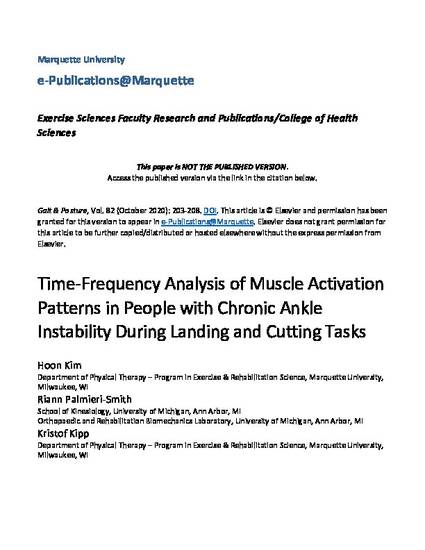
Background
People with chronic ankle instability (CAI) exhibit neuromuscular deficits. Previous studies, however, only investigated magnitudes of muscle activation and not the time-frequency domain. Research question
Do people with CAI exhibit differences in muscle activation patterns in the time-frequency domain during landing, anticipated cutting, and unanticipated cutting compared to matched controls? Methods
Eleven people with CAI and eleven healthy matched controls (CON) performed landing, anticipated cutting, and unanticipated cutting as surface EMG of the lateral gastrocnemius, medial gastrocnemius, fibularis longus, soleus, and tibialis anterior were recorded. The time-frequency domain of surface EMG data was analyzed with wavelet transformations and principal component analysis (PCA), PC scores were compared across group, task, and muscle with three-way ANOVAs. Results
The PCA extracted two PCs that captured the overall magnitude (PC1) of wavelet intensities across the time-frequency domain and a shift among the range of frequencies (PC2) where wavelet intensities were most prominent. A main effect for group indicated that people with CAI demonstrated smaller (p = 0.009) PC1 scores than people in the CON group across all muscles and tasks. An interaction between group and task indicated that people in the CAI group exhibited smaller (p = 0.041) PC2 scores than people in the CON group during only anticipated cutting. Significance
People with CAI exhibited neuromuscular deficits in the time-frequency domain of EMG during dynamic tasks. These deficits appear to reflect a neuromuscular strategy characterized by the recruitment of fewer motor units in ankle muscles regardless of task, and an inability to scale the recruitment of motor units in the frequency domain in response to different task demands. Rehabilitation for people with CAI should consider that this population exhibits differences in neuromuscular control that exist not only in the overall magnitudes, but also in the time-frequency domain, of muscle activation patterns.
Available at: http://works.bepress.com/kristof-kipp/30/
Accepted version. Gait & Posture, Vol. 82 (October 2020): 203-208. DOI. © 2020 Elsevier. Used with permission.